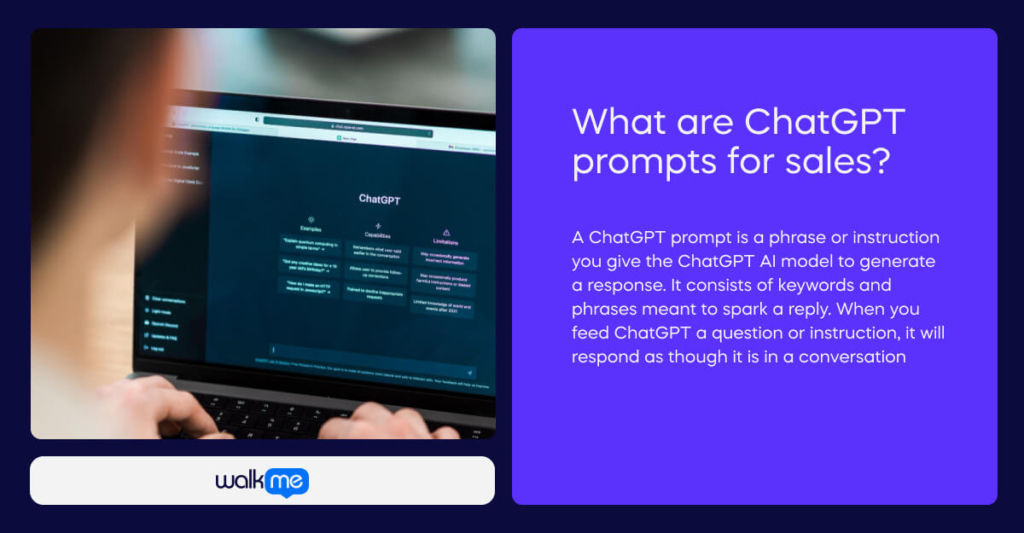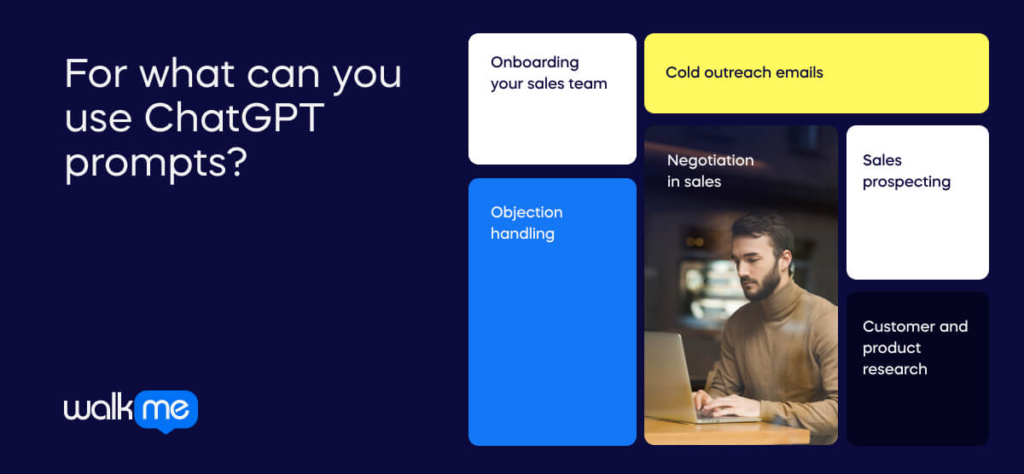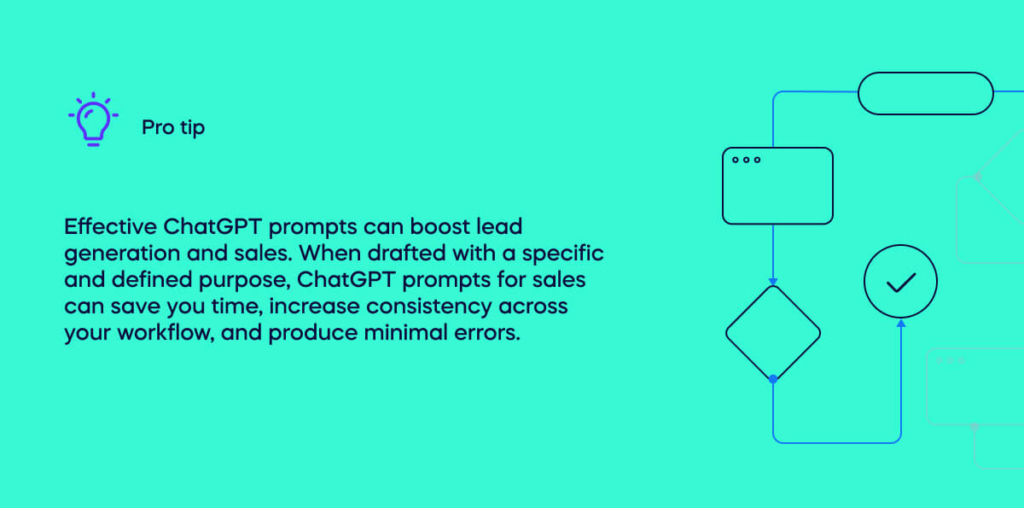AI tools are an essential part of an effective sales strategy. They can increase revenue for your business, accelerate deal cycles, improve forecasting accuracy, and enhance profit margins.
It’s for this reason that ChatGPT has already permeated much of the sales industry, allowing sales executives to executives to effectively hit their KPIs.
Latest research from McKinsey suggests the new tech could boost sales performance, adding a whopping $4.4 trillion annually to the global economy.
And it’s not just about driving profits. ChatGPT can save valuable time for salespeople, too. Some estimate AI could automate up to 70 percent of tasks currently eating up employees’ time today. But, as Emmert Wolf wrote over a century ago, “a man is only as good as his tools.”
To become proficient with this particular tool, it’s integral for any salesperson to master the art of the prompt.
In this article, we’ll examine the best ChatGPT prompts for sales, their use cases, and why crafting great ChatGPT prompts is so important for sales representatives.
What are ChatGPT prompts for sales?

A ChatGPT prompt is a phrase or instruction you give the ChatGPT AI model to generate a response. It consists of keywords and phrases meant to spark a reply. When you feed ChatGPT a question or instruction, it will respond as though it is in a conversation.
ChatGPT is passive. A salesperson has to poke and prod it with new messages to get a response. Whether requesting a six-month sales plan or generating a sales negotiation strategy, these user-generated requests are known as ‘prompts.’
Prompt engineering involves crafting prompts to elicit specific responses. Perfecting your prompt is a powerful way of driving sales. Many, including Forbes, predict that ChatGPT trainers and prompters “will be more in demand than field sales agents” in the future.
How to use ChatGPT prompts for sales
Ensure that your ChatGPT prompts are efficient in driving sales by following these four steps:
- Familiarize yourself with ChatGPT: The free version of ChatGPT has a knowledge cutoff as of January 2022, lacks integration capabilities, and imposes limits such as 40 messages every three hours. ChatGPT Plus, which costs $20 per month, allows uninterrupted access during peak hours, faster response times, and gives priority access to ChatGPT-4 features, including image prompt processing and multilingual support.
- Determine your goal: Assess which areas of your business you’d like to automate. What would you like to achieve using ChatGPT prompts? How will you measure its success?
- Get creative when crafting your prompt: Write your prompt based on the goal you’ve set. Get creative with it, but ensure you have laid a clear objective for the prompt.
- Submit, review, and refine: Submit the prompt into ChatGPT, evaluate its output, and refine the prompt if needed—don’t be afraid to experiment. Rinse and repeat until you achieve your desired output.
- Evaluate ChatGPT’s results critically: AI-generated content isn’t guaranteed to be error-free. Fact-check the responses to your prompts and add a human touch when needed.
12 ChatGPT prompts for sales tactics

Below is a list of prompts for ChatGPT that you can use today to enhance your sales strategy.
- Onboarding your sales team
Prompt: “You are leading a team of sales representatives. Develop a [specify amount of words] onboarding guide for new sales reps so they can take [desired action] quickly and efficiently.”
Alternative prompt: “You are leading a team of sales representatives. Create a [specify amount of words] onboarding guide for new sales team members, including [sales tools your company uses] and [your team’s work culture and goals].”
When to use it: This prompt is best used to boost your sales performance of new employees. You should tailor this prompt to your organization’s needs, ensuring that new sales reps can hit the ground running and start driving profits efficiently.
Knowledge needed: You should determine the amount of words the onboarding process should be tailored to your business’s specific needs. You should also choose the desired action for new sales reps. This will differ depending on the nature of your business plan and goals, for instance, setting up product demos, making sales calls, and closing deals.
- Objection handling
Prompt: “You are a sales representative. Draft three scripts for handling common sales objections. Here is some information to help you with the task: [input details about common objections faced in your business], [input details about the product or service you’re offering].”
Alternative Prompt: “You are a sales representative. Create a role-play scenario for an objection handling training session. Here is some information to help you with the request: [input details about the sales situation for the role-play], [input specific objectives for the objection handling].”
When to use it: This prompt is best used when addressing the prospect’s concerns about products or services. The output from ChatGPT can then assist you in creating a technical, organizational, or personal buy-in.
Knowledge needed: This prompt is most effective when you know the common objections your business faces. Make sure you’ve clearly stated how your product or service will address these pain points, too. Once ChatGPT has given you its output, personalize your message for your specific prospect.
- Negotiation in sales
Prompt: “You are a sales representative. Generate a negotiation strategy for a potential deal. Ensure that [input details about customer’s needs] are met. Acknowledge [input details about the customer’s objections]. Make sure to sell persuasively [input details about the product or service you’re offering].”
Alternative Prompt: “You are a sales representative. Draft a message for a counteroffer in response to a customer’s objections. The original offer includes [input details about the original offer]. Show that you acknowledge [input details about the customer’s objections]. Draft the message with the following negotiation strategy in mind: [input details about your negotiation strategy and any other relevant information].
When to use it: These prompts are best utilized in a sales strategy negotiation process. Alongside human insight, ChatGPT can offer a secondary view of the pain points of a potential client. It can also help brainstorm the best methods to persuade a prospect to buy your product or service. Prompts for negotiation can be particularly effective when sales reps balance multiple negotiation strategies with several potential clients.
Knowledge needed: You’ll need a solid understanding of a target’s objections and how your product or service will resolve your prospect’s needs and pain points. Having a nuanced understanding of the person you’re negotiating with is also important. ChatGPT can often produce generic responses, which can be counterproductive for your negotiation strategy. Make sure to give your strategy a unique and personal touch while maintaining professionalism.
- Cold outreach emails
Prompt: “You are a sales representative. Generate a cold email idea to engage my [input customer profile]. Compare my [product/service] to similar options on the market and persuade my [ideal customer persona] to choose us with clear and compelling evidence.”
Alternative prompt: “You are a sales representative. Generate a cold email idea that will establish trust and credibility with [input customer profile] by showcasing the expertise and professionalism of my [your service or product].”
When to use it: This prompt is best used in the initial phase of your cold outreach strategy. It can help form the basis of your outreach email, which will later be tailored to your specific target. Cold outreach is a challenging sales strategy. ChatGPT won’t replace the human touch and insight needed, but it will ensure the process is more efficient.
Knowledge needed: Balance is key here. While a deep and nuanced understanding of your target’s pain points is unrealistic, a general sense of who they are and what will draw them to your product or service is necessary. Do some light research on your outreach target, and include those details in your prompt.
- Sales prospecting
Prompt: “You are a sales representative. Write a check-in email to [prospecting lead], maintaining a friendly yet professional tone. Offer to answer their questions and reaffirm our readiness to assist. Encourage ongoing dialogue by offering a check-in call.”
Alternative prompt: “You are a sales representative. Write an email announcing our exclusive offer [offer details] specifically tailored for [propsecting lead]. Clearly emphasize the value and instill a sense of urgency for this limited-time offer.”
When to use it: This prompt can assist you in reaching prospecting clients and entering them into the sales funnel until they’re ready to buy from you. Automating this process can be a valuable way to save time while also maintaining a relationship with your prospecting customer or client.
Background knowledge needed: It’s best to have an initial understanding of your prospecting client’s wants, needs, and pain points. Before drafting the prompt, also assess the value of your prospecting target or lead and how likely they are to enter your sales funnel. If the prospect is particularly valuable, it’s best to avoid a generic prompt and tailor the output to their needs instead.
Customer and product research
Prompt: “You are a market researcher. Analyze customer preferences and behaviors in the [type of product or service] market or industry to inform our marketing strategy. What are the strengths and weaknesses of [your competitor]? In the strategy draft, address how [your product or service] addresses these weaknesses while asserting our strengths.”
Alternative prompt: “You are a market researcher. Analyze the [type of product or service] industry to develop our pricing and positioning strategy. Use data to compare and contrast the [type of product or service] market across different countries and regions.”
When to use it: Using ChatGPT for customers and producing research can help you get the insights you need to create a successful marketing campaign. The AI takes a holistic approach to your industry, concluding how you can excel in that market.
Knowledge needed: Before drafting the prompt, it’s best to have a solid understanding of your industry. This will assist you in creating the best customer or product research strategy and allow you to fact-check information when needed.
Increase efficiency and drive sales using ChatGPT prompts
We’ve provided a lengthy list of prompts that you can use today to build your business, better understand your market, gain cold leads, and ultimately drive sales. But it’s important to note that this list isn’t exhaustive. That’s the magic of AI–it’s limitless.
While neglecting ChatGPT will leave you behind compared to your competitors, it’s also important to be aware of its many risks. There are countless legal issues associated with AI, but it’s also important to remember that prompts don’t always produce correct answers.
Keep this in mind when using ChatGPT for your sales, and also ensure you manually fact-check every output with a fine-tooth comb. Moreover, there’s a risk of becoming overly reliant on ChatGPT prompts for sales. Make sure to regularly and critically evaluate your prompts: get creative and tailor your ChatGPT prompts to your specific needs.

Regardless, effective ChatGPT prompts can boost lead generation and sales. When drafted with a specific and defined purpose, ChatGPT prompts for sales can save you time, increase consistency across your workflow, and produce minimal errors.


